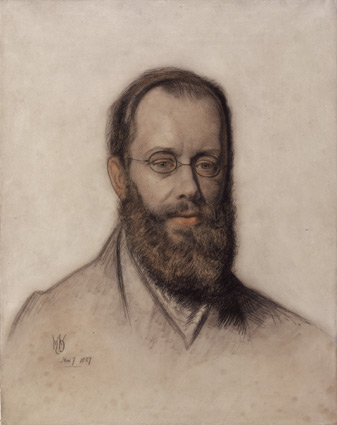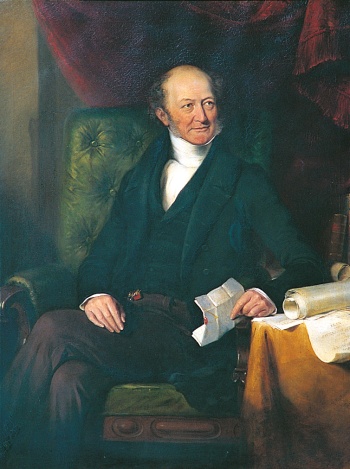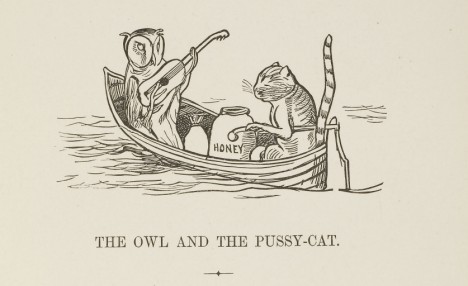Brief Biography
The British poet and painter known for his absurd wit, Edward Lear was born on May 12, 1812 and began his career as an artist at age 15. His father, a stockbroker of Danish origins, was sent to debtor’s prison when Lear was thirteen and the young Lear was forced to earn a living. Lear quickly gained recognition for his work and in 1832 was hired by the London Zoological Society to execute illustrations of birds. In the same year, the Earl of Derby invited Lear to reside at his estate; Lear ended up staying on until 1836.
His first book of poems, A Book of Nonsense (1846) was composed for the grandchildren of the Derby household. Around 1836 Lear decided to devote himself exclusively to landscape painting (although he continued to compose light verse). Between 1837 and 1847 Lear traveled extensively throughout Europe and Asia.
After his return to England, Lear’s travel journals were published in several volumes as The Illustrated Travels of a Landscape Painter. Popular and respected in his day, Lear’s travel books have largely been ignored in the twentieth century. Rather, Lear is remembered for his humorous poems, such as “The Owl and the Pussycat,” and as the creator of the form and meter of the modern limerick. Like his younger peer Lewis Carroll, Lear wrote many deeply fantastical poems about imaginary creatures, such as “The Dong with the Luminous Nose.” His books of humorous verse also include Nonsense Songs (1871) and Laughable Lyrics (1877). Lear died on January 29, 1888 at the age of 76.
Although the subject and form of his works varies greatly, all of Lear’s poems can be characterized by his irreverent view of the world; Lear poked fun at everything, including himself in “By Way of a Preface.” Many critics view Lear’s devotion to the ridiculous as a method for dealing with or undermining the all-pervasive orderliness and industriousness of Victorian society. Regardless of impetus, the humor of Lear’s poems has proved irrefutably timeless.
The Life of Edward Lear
Edward Lear was an English artist, illustrator, author, and poet, renowned today primarily for his literary nonsense, in poetry and prose, and especially his limericks, a form that he popularised.
Biography

Lear was born into a middle-class family in the village of Holloway, the 21st child of Ann and Jeremiah Lear. He was raised by his eldest sister, also named Ann, 21 years his senior. Ann doted on Lear and continued to mother him until her death, when Lear was almost 50 years of age. Due to the family’s failing financial fortune, at age four he and his sister had to leave the family home and set up house together.
Lear suffered from health problems. From the age of six he suffered frequent grand mal epileptic seizures, and bronchitis, asthma, and in later life, partial blindness. Lear experienced his first seizure at a fair near Highgate with his father. The event scared and embarrassed him. Lear felt lifelong guilt and shame for his epileptic condition. His adult diaries indicate that he always sensed the onset of a seizure in time to remove himself from public view. How Lear was able to anticipate them is not known, but many people with epilepsy report a ringing in their ears (tinnitus) or an aura before the onset of a seizure. In Lear’s time epilepsy was believed to be associated with demonic possession, which contributed to his feelings of guilt and loneliness. When Lear was about seven he began to show signs of depression, possibly due to the constant instability of his childhood. He suffered from periods of severe depression which he referred to as “the Morbids.”
Lear travelled widely throughout his life and eventually settled in Sanremo, on his beloved Mediterranean coast, in the 1870s, at a villa he named “Villa Tennyson.” The closest he came to marriage was two proposals, both to the same woman 46 years his junior, which were not accepted. For companions he relied instead on a circle of friends and correspondents, and especially, in later life, on his Albanian Suliot chef, Giorgis, a faithful friend and, as Lear complained, a thoroughly unsatisfactory chef. Another trusted companion in Sanremo was his cat, Foss, who died in 1886 and was buried with some ceremony in a garden at Villa Tennyson. After a long decline in his health, Lear died at his villa in 1888, of the heart disease from which he had suffered since at least 1870. Lear’s funeral was said to be a sad, lonely affair by the wife of Dr. Hassall, Lear’s physician, not one of Lear’s many lifelong friends being able to attend.
Lear is buried in the Foce Cemetery in Sanremo. On his headstone are inscribed these lines about Mount Tomohrit (Albania) from Tennyson’s To E.L. [Edward Lear], On His Travels in Greece:
Tomohrit, Athos, all things fair.
With such a pencil, such a pen.
You shadow forth to distant men,
I read and felt that I was there.
Edward Lear was known to introduce himself with his long name: “Mr Abebika kratoponoko Prizzikalo Kattefello Ablegorabalus Ableborinto phashyph” or “Chakonoton the Cozovex Dossi Fossi Sini Tomentilla Coronilla Polentilla Battledore & Shuttlecock Derry down Derry Dumps” which he based on Aldiborontiphoskyphorniostikos.
The centenary of his death was marked in Britain with a set of Royal Mail stamps in 1988 and an exhibition at the Royal Academy. Lear’s birthplace area is now badged with a plaque at Bowman’s Mews, Islington in London and his bicentenary in 2012 celebrated with a range of events, exhibitions and lectures in venues across the world including an International Owl and Pussycat Day on his birthday.
Artist

Lear was already drawing “for bread and cheese” by the time he was aged 16 and soon developed into a serious “ornithological draughtsman” employed by the Zoological Society and then from 1832-36 by the Earl of Derby, who had a private menagerie. His first publication, published when he was 19, was Illustrations of the Family of Psittacidae, or Parrots in 1830. His paintings were well received and he was favourably compared with Audubon.
Edward Lear, who showed an early interest in drawing the natural world, came to Knowsley through a fortuitous connection with the 13th Earl of Derby. In June 1830, Lear applied to the Zoological Society of London to request permission to draw from their collection of parrots, with a view to publishing his own book Illustrations of the Family of Psittacidae. Lord Stanley, later 13th Earl of Derby, who as a young man had begun to collect natural history books and drawings, happened to chair the meeting where this application was approved.
Lord Stanley subsequently commissioned Lear to paint the birds and mammals from the aviary and menagerie which he had set up at Knowsley. During the years 1831–1837 that Lear was at Knowsley, his relationship with Edward Stanley became increasingly less formal. Over this period, in addition to drawing and painting, Lear entertained the children of the Stanley family. In fact, he dedicated his first collection of rhymes, published as A Book of Nonsense in 1846, to the 13th Earl’s great-grandchildren, grand-nephews, and grand-nieces.
In 1837, Lear left Knowsley for Rome, a move which was fully supported by Edward Stanley, now 13th Earl of Derby, as part of his personal and artistic development. With a base in Rome, the artist travelled for the following eleven years through Italy, and it was during this period that he established himself as a landscape painter. However, Lear’s connection with the Stanley family was retained as he sent paintings back to the 13th Earl. Also later, after the death of the 13th Earl, as Lear travelled through southern Europe and further afield, the 14th and 15th Earls of Derby continued to buy Lear’s work.
Lear travelled for three years in Italy from 1837 and published two volumes of illustrations, Illustrated Excursions in Italy, the first of many such books. Lear briefly gave drawing lessons to Queen Victoria, who had been pleased by the Excursions and summoned him to court, leading to some awkward incidents when he failed to observe proper court protocol. Lear then returned to the Mediterranean, wishing to illustrate all points along the coast of that sea.
Among other trips, he visited Greece and Egypt in 1848-49, and toured the length of India and Ceylon in 1873-75. While travelling he produced large quantities of coloured wash drawings in a distinctive style, which he worked up back in his studio into oils and watercolours, as well as prints for his books. His landscape style often shows views with strong sunlight, with intense contrasts of colour.
Throughout his life he continued to paint seriously. He had a lifelong ambition to illustrate Tennyson’s poems; near the end of his life a volume with a small number of illustrations was published, but his vision for the work was never realized.
Author
In 1846 Lear published A Book of Nonsense, a volume of limericks that went through three editions and helped popularize the form. In 1865 The History of the Seven Families of the Lake Pipple- Popple was published, and in 1867 his most famous piece of nonsense, The Owl and the Pussycat, which he wrote for the children of his patron Edward Stanley, 13th Earl of Derby. Many other works followed.
Lear’s nonsense books were quite popular during his lifetime, but a rumour circulated that “Edward Lear” was merely a pseudonym, and the books’ true author was the man to whom Lear had dedicated the works, his patron the Earl of Derby. Supporters of this rumour offered as evidence the facts that both men were named Edward, and that “Lear” is an anagram of “Earl”.
Lear’s Limericks

Lear’s nonsense works are distinguished by a facility of verbal invention and a poet’s delight in the sounds of words, both real and imaginary. A stuffed rhinoceros becomes a “diaphanous doorscraper”. A “blue Boss-Woss” plunges into “a perpendicular, spicular, orbicular, quadrangular, circular depth of soft mud”. His heroes are Quangle-Wangles, Pobbles, and Jumblies. His most famous piece of verbal invention, a “runcible spoon” occurs in the closing lines of The Owl and the Pussycat, and is now found in many English dictionaries:
They dined on mince, and slices of quince
Which they ate with a runcible spoon;
And hand in hand, on the edge of the sand,
They danced by the light of the moon,
The moon,
The moon,
They danced by the light of the moon.
Though famous for his neologisms, Lear employed a number of other devices in his works in order to defy reader expectations. For example, “Cold Are The Crabs”, adheres to the sonnet tradition until the dramatically foreshortened last line.
Limericks are invariably typeset as four plus one lines today, but Lear’s limericks were published in a variety of formats. It appears that Lear wrote them in manuscript in as many lines as there was room for beneath the picture. In the first three editions most are typeset as, respectively, two, five, and three lines. The cover of one edition bears an entire limerick typeset in two lines:
There was an Old Derry down Derry, who loved to see little folks merry;
So he made them a book, and with laughter they shook at the fun of that Derry down Derry.
In Lear’s limericks the first and last lines usually end with the same word rather than rhyming. For the most part they are truly nonsensical and devoid of any punch line or point. They are completely free of the off-colour humour with which the verse form is now associated. A typical thematic element is the presence of a callous and critical “they”. An example of a typical Lear limerick:
There was an Old Man of Aôsta,
Who possessed a large Cow, but he lost her;
But they said, ‘Don’t you see,
she has rushed up a tree?
You invidious Old Man of Aôsta’
Lear’s self-portrait in verse, How Pleasant to know Mr. Lear, closes with this stanza, a reference to his own mortality:
He reads but he cannot speak Spanish,
He cannot abide ginger-beer;
Ere the days of his pilgrimage vanish,
How pleasant to know Mr. Lear
Five of Lear’s limericks from the Book of Nonsense, in the 1946 Italian translation by Carlo Izzo, were set to music for choir a cappella by Goffredo Petrassi, in 1952.
Edward Lear’s Works:
Mount Timohorit, Albania (1848)
Illustrations of the Family of the Psittacidae, or Parrots (1832)
Tortoises, Terrapins, and Turtles by J.E. Gray
Views in Rome and its Environs (1841)
Gleanings from the Menagerie at Knowsley Hall (1846)
Illustrated Excursions in Italy (1846)
Book of Nonsense (1846)
Journal of a Landscape Painter in Greece and Albania (1851)
Journal of a Landscape Painter in Southern Calabria (1852)
Book of Nonsense and More Nonsense (1862)
Views in the Seven Ionian Isles (1863)
Journal of a Landscape Painter in Corsica (1870)
Nonsense Songs and Stories (1871)
More Nonsense Songs, Pictures, etc. (1872)
Laughable Lyrics (1877)
Nonsense Alphabets
Nonsense Botany (1888)
Tennyson’s Poems, illustrated by Lear (1889)
Facsimile of a Nonsense Alphabet (1849, but not published until 1926)
The Scroobious Pip, unfinished at his death, but completed by Ogden Nash and illustrated by Nancy Ekholm Burkert (1968)
The Quangle-Wangle’s Hat (unknown)